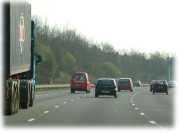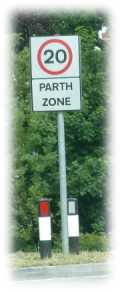Reading the road - project
 This project is designed to further raise your awareness of hazards by developing your ability to plan well ahead, to drive as fluently as possible, to make maximum progress and minimise the need to stop.
This project is designed to further raise your awareness of hazards by developing your ability to plan well ahead, to drive as fluently as possible, to make maximum progress and minimise the need to stop.
Inability to read the road and plan well ahead (coupled with lack of attention) is possibly the biggest cause of road accidents in this country and indeed around the world.
This, in itself, is a sound enough reason for developing your skill in this area. However, the reasons for developing your ability to plan well ahead when driving go well beyond accident prevention.
Project one
Spend two sessions, each of around one hour's duration, concentrating on trying to keep your car moving, i.e., planning your drive so that you never get held up at roundabouts, traffic lights, etc.
Your route should include suburban and rural "A" class roads with a reasonable volume of traffic.
With a little practise this can become a 'healthy obsession'. Even in fairly busy traffic you will often be able to drive for five minutes or more without needing to stop (including some junctions where good planning and slow speed will enable you to keep moving safely).
NOTE: This is a planning and speed control exercise. You should rarely, if ever, need to accelerate to 'beat' another vehicle in order to avoid a stop.
Project two
As an additional project you might want to have a go at the 'Motorway speed game' if you have not tried it earlier in the course.
To play this game you simply have to keep a fixed speed on a moderately busy motorway for as long as possible – choose 50, 60 or 70mph and maintain your speed by careful forward planning while maintaining the rules governing lane discipline.
Cruise control can often make this a challenging project!
Your targets
 When driving normally I never exceed the speed limits
When driving normally I never exceed the speed limits
When asked about speed limits many drivers will openly admit to breaking the limit but they always add "Only when it's safe to do so, of course".
If it were safe to drive at a higher speed there would not be a limit in place. There are arguments for higher national speed limits but as an advanced driver you must accept the law as it stands and abide by it at all times.
Quite often by driving well within the speed limit in built up areas you will create opportunities to proceed which you might otherwise miss (if travelling too fast).
When driving I keep my eyes moving, constantly scanning the road ahead and behind
Many drivers, either consciously or unconsciously, simply watch the car in front.
In order to plan ahead you need to get as much information about the road and traffic situation as possible.
When driving normally I always look well ahead for vehicles that are slowing down or pulling out.
When vehicles change their speed and position ahead they will affect you. The earlier that you see this happen the more you can act to minimise the effect.
The driver of the car in the picture has not yet noticed that the truck is about to move out without signalling. By looking well ahead and allowing for the 'unexpected' you will not fall into a similar trap.
When driving normally I always consider the time of day.
As discussed earlier in section, the time of day can have big impact on your driving. perhaps the obvious example is that of children going to and from school, however there are lots of other situations where time of day is critical.
For example, you might need to allow more time for early morning trips through town because of delivery trucks – doing this will save the frustration that comes from being 'late' and which in turn, causes accidents.
When driving normally I always consider the type of road that I'm driving on.
Remember that different roads have different hazards.
If you normally drive in town, you will need to adopt a different mind set when on country roads.
If you live in a very flat area, you will need to think differently to consider the potential problems that you may encounter if driving on a mountain road.
And so on ...
When driving normally I always maintain a useful road position and check my mirrors frequently.
Always adopt a road position that enables you to see well ahead. This is particularly important if you are in a strange area and looking out for road signs.
Frequent mirror checks will ensure that you are always ready to change your speed and position to take advantage of changes in the traffic situation.
A typical example would be ensuring that plan your driving so that you never get 'boxed in' behind a large vehicle on a fast moving motorway or dual-carriageway.
When driving normally I always concentrate on the available space ahead and not the obstructions.
This may seem obvious, but most drivers fail to do it. You should always be looking for space.
For example, if the driver in situation pictured here had slowed down sooner, he could have timed his approach to arrive at the restricted part of the road when it was clear.
Incidentally, looking at obstructions, rather than spaces, is one of the major causes of steering problems and hesitancy in inexperienced drivers.
When driving normally I always make best use of my acceleration sense.
Acceleration sense is the ability to sense the amount of accelerator pressure needed to propel the car along any given stretch of road.
This ability is perhaps better understood if you think of it as deceleration sense.
For example, if you want to stop on an uphill gradient, acceleration sense would tell you when to take your foot off the gas pedal in order to stop exactly where you want, without needing the brake pedal.
On the open road good acceleration sense is essential for smoothness and balance.
If you have not already done so, develop your acceleration sense by finding a stretch of open country road about 5 to 10 miles long (no give-way or stop junctions) and drive along it as if you have no brakes.
Try to gauge when to come off the gas to slow down for bends, hills and slower moving vehicles ahead. Do not use the gears to slow the car down, change gear only if you need more power for acceleration or stability though bends.
Next: Step 2 - Reading the road - Checklist...